Efficient Sparse Signal Transmission over a Lossy Link Using Compressive Sensing
Abstract
:1. Introduction
- We demonstrated the feasibility of incorporating compressive sensing as an error correction measure to facilitate communication over lossy wireless links.
- We propose a new cyber-physical measurement process model in applying compressive sensing where the packet loss in a wireless link is modeled as a random sampling process.
- We propose a novel wireless link performance metric, called the information acquisition rate, to measure the actual information content that is transferred. We show that this metric better reflects the actual performance of data transmission than the conventional data-oriented criteria, such as the packet reception rate.
- We established important relations between packet lengths and the mutual coherence, which is critical to the success of compressive sensing reconstruction.
2. Related Work
| Symbol | Explanation |
|---|---|
| x | sampled signal, |
| reconstruction signal, | |
| ε | reconstruction error, |
| N | dimension of sampled signal |
| M | dimension of projection (measurement) vector |
| Ψ | fast Fourier transform matrix, |
| Φ | projection matrix, |
| α | coefficients that represent x on the basis Ψ, |
| K | nonzero coefficients in α |
| A | equivalent matrix, |
| y | measurement vector, |
| mutual coherence | |
| column-normalized version of A | |
| G | |
| packet reception rate (PRR) | |
| bit error rate (BER) | |
| L | packet length |
| overhead length | |
| payload length | |
| n | packet number |
3. Compressive Sensing
3.1. Compressive Sensing Fundamentals
- Sparsity: Let represent the N-dimension original signal and be an orthogonal basis (dictionary), such that:where is the vector that represent x on the basis Ψ. The signal is sparse if most of the elements of α are zero or they can be discarded without much loss of information. Specifically, if there are nonzero coefficients in α, the signal can be regarded as being K-sparse. In fact, sparse signals are rather ubiquitous, such as acoustic signal, temperature, the density of carbon dioxide and images, which allows compressive sensing to be applied in many far-reaching applications in WSNs [23].
- Incoherent measurement: For any N-dimensional signal x, its measurement y is taken as follows:where is the M-dimensional linear measurement data, is the projection matrix and is the equivalent matrix. Compressive sensing theory requires the projection matrix Φ and the sparse dictionary to be as incoherent as possible, such that the samples add new information that is not already represented by the known basis Ψ. It has been proven [24] that Φ with i.i.d. Gaussian entries with zero mean and variance or binary matrices with independent entries taking values are largely incoherent with any fixed sparse dictionary Ψ with overwhelming probability as long as the measurement number conforms to the following condition, holding for some constant c:
- Reconstruction algorithms: K-sparse x can be reconstructed by solving the norm [10] from y as follows:This optimization problem relies on an exhaustive search and is successful for all when the matrix Φ has the sparse solution uniqueness property. However, this algorithm has combinatorial computational complexity [25]. An alternative to the above norm optimization is to use the norm. norm optimization is convex, which can be solved by using linear programming, and the global optimal solutions can be achieved. An alternative to optimization-based approaches is greedy algorithms for sparse signal recovery. These methods are iterative in nature and select columns of Φ according to their correlation with the measurements y determined by an appropriate inner product. A typical example is orthogonal matching pursuit algorithms (OMP), which we use in our framework due to the low complexity. Still, the computational complexity of this solution is greater than that of traditional decoding and data interpolation, but CS shifts this burden to the base station, which we assume to have a significantly higher energy budget than the ordinary sensor nodes. Considering that the data have noise in practice, basis pursuit de-noising (BPDN) (also called LASSO) is adopted to minimize the usual sum of square errors, which can be formatted as a -penalty least squares estimate problem:It should be noted that some authors reserve this term for the related optimization problem, with a bound on the sum of the absolute value:
3.2. Compressive Sensing Applications
4. Sparse Signal Transmission Framework
4.1. Background
4.1.1. Lossy Wireless Link
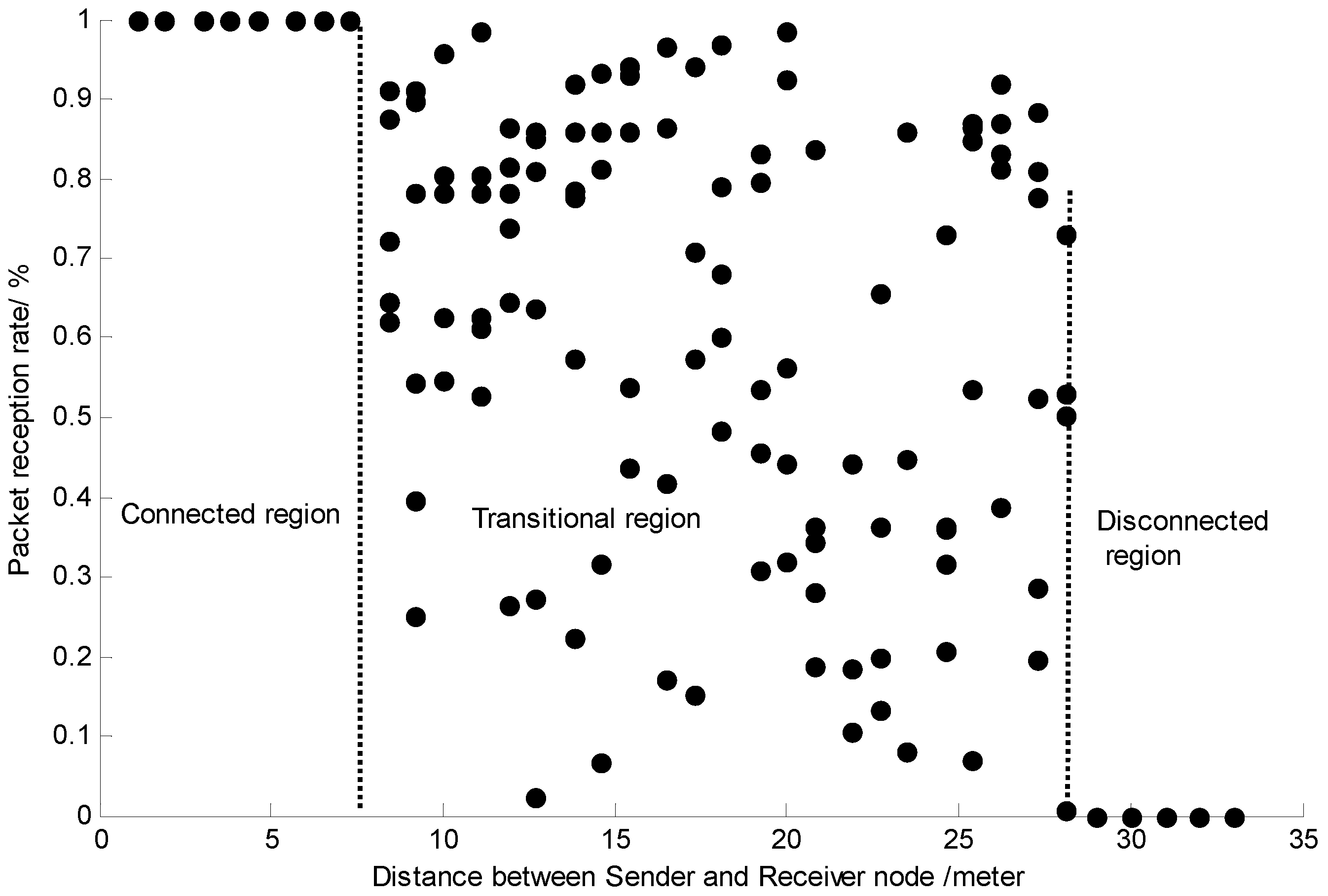
4.1.2. Ubiquity of Sparse Signals
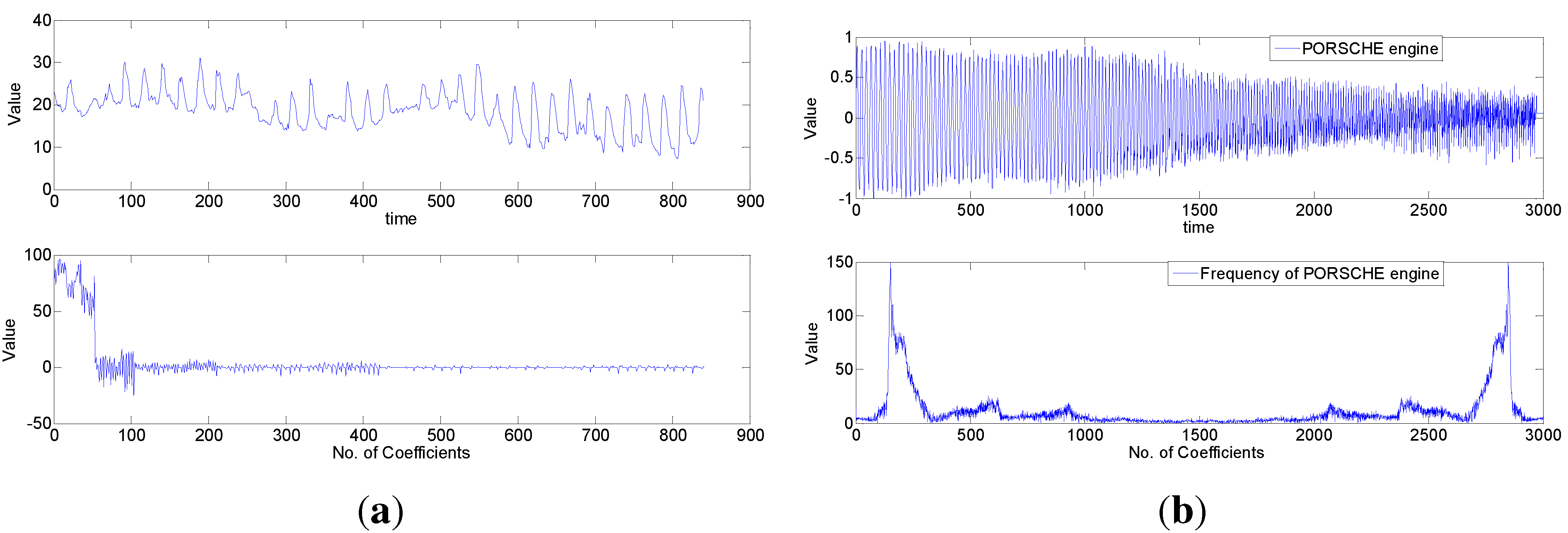
4.2. Process of Sparse Signal Transmission

4.3. Problem Formulation

5. Packet Length Control for Sparse Signal Transmission
5.1. Packet Length Effect on Mutual Coherence

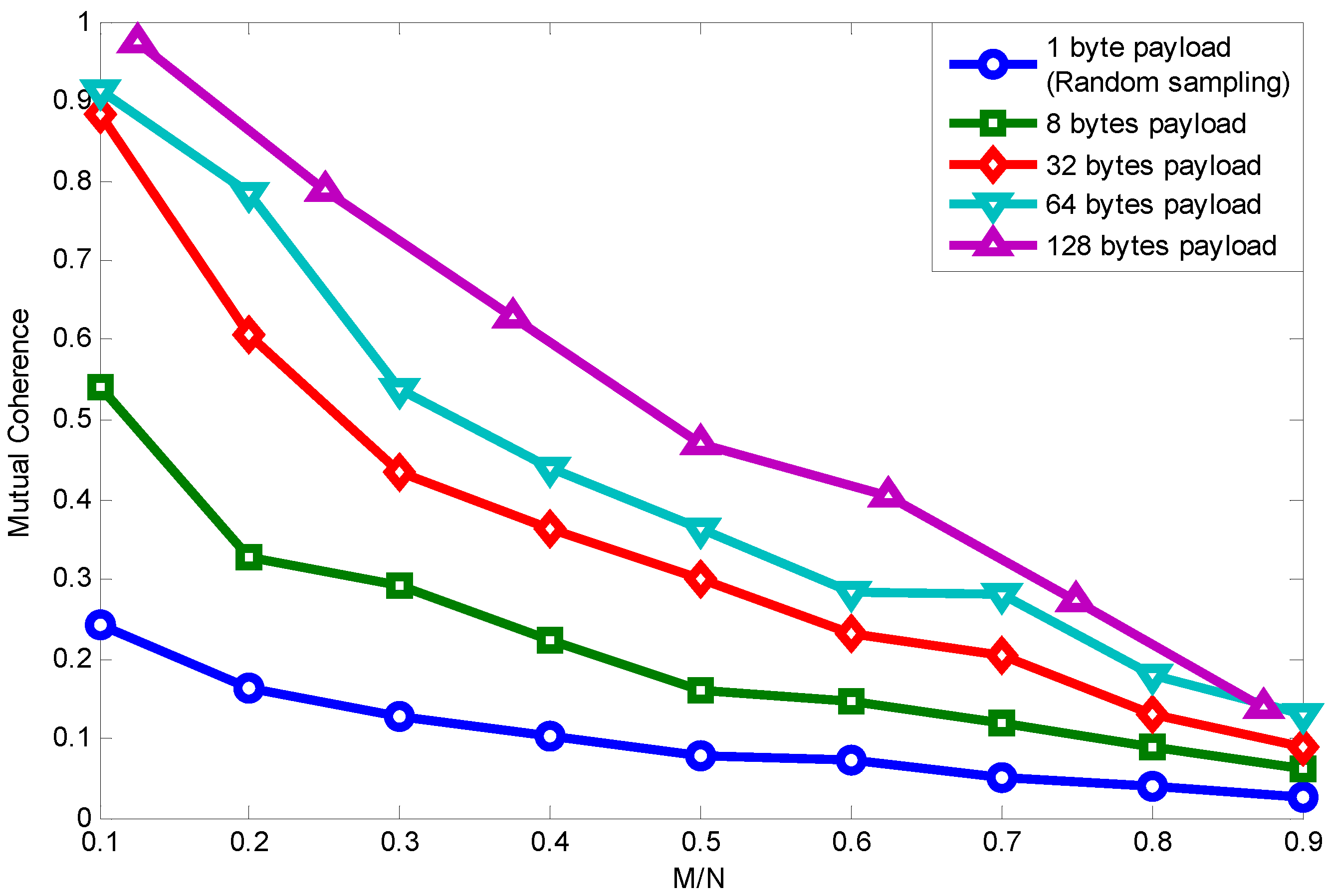
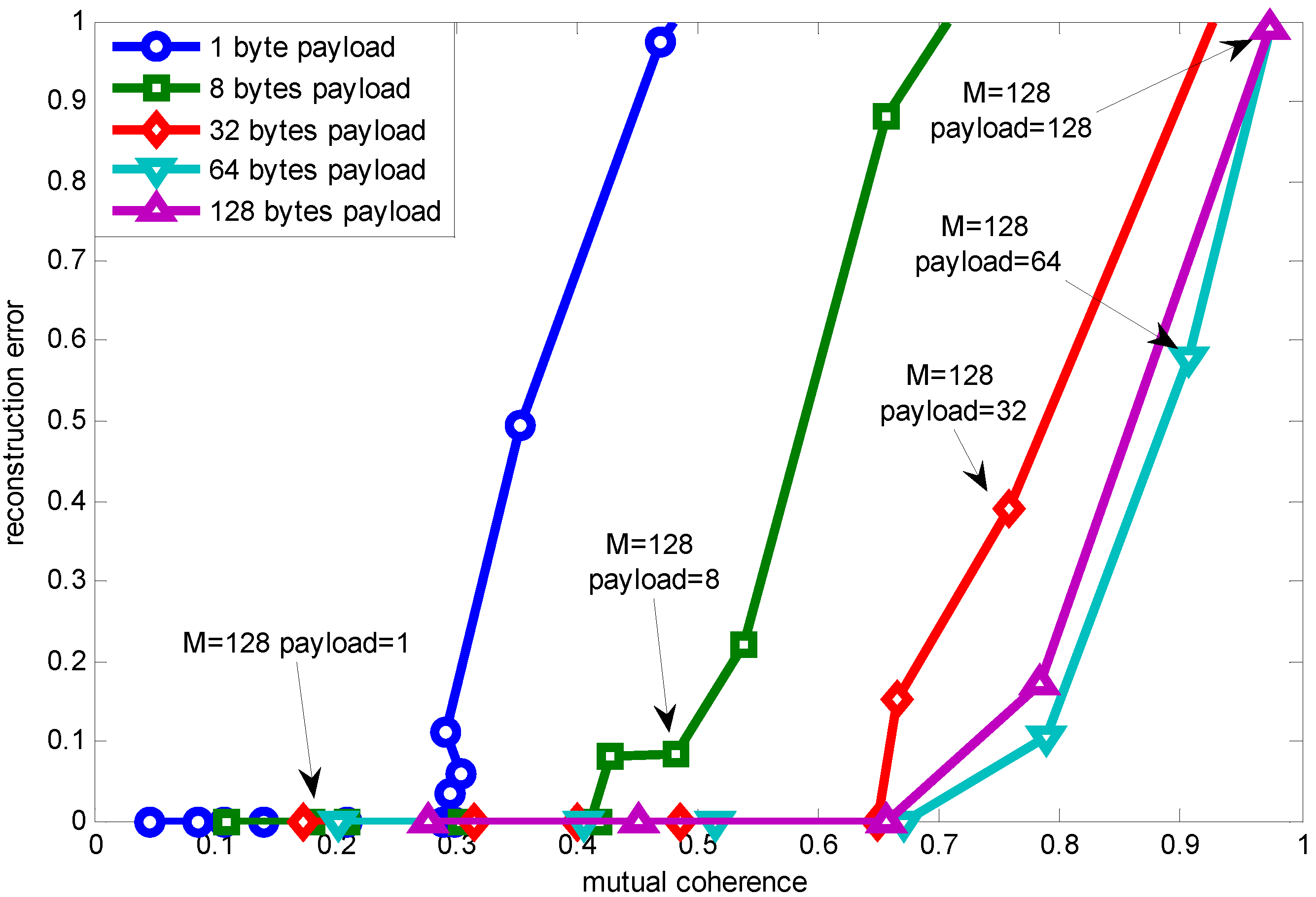
5.2. Relationship between Communication Parameter and Mutual Coherence

5.2.1. Combined Effects of BER and Packet Length on PRR
5.2.2. Threshold of PRR for Reliable Signal Reconstruction
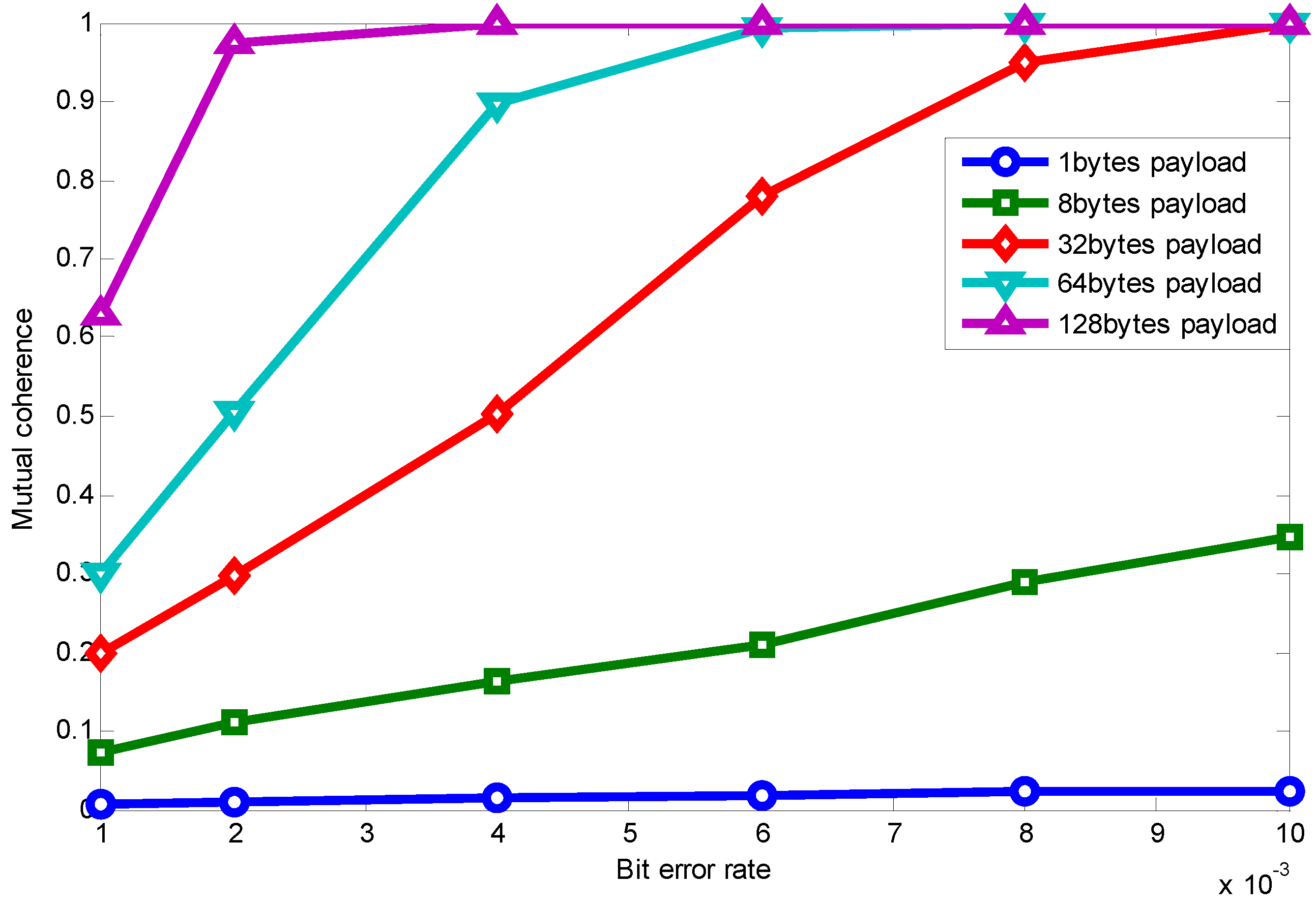
5.3. Performance Improvement with Data Interleaving
5.3.1. An Easy-to-Implement Method: Interleaving
5.3.2. Interleaving Effect on Sparse Signal Transmission
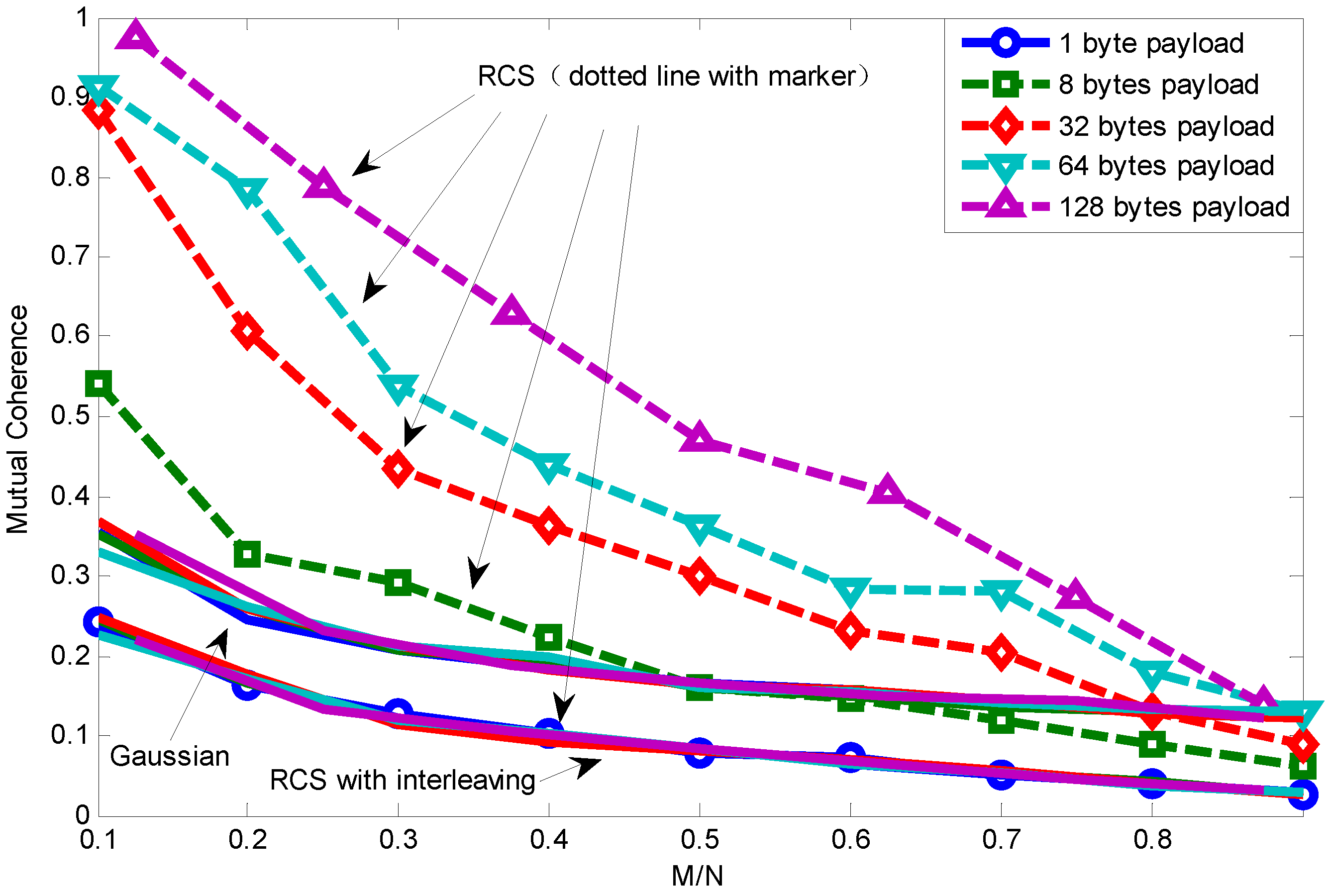
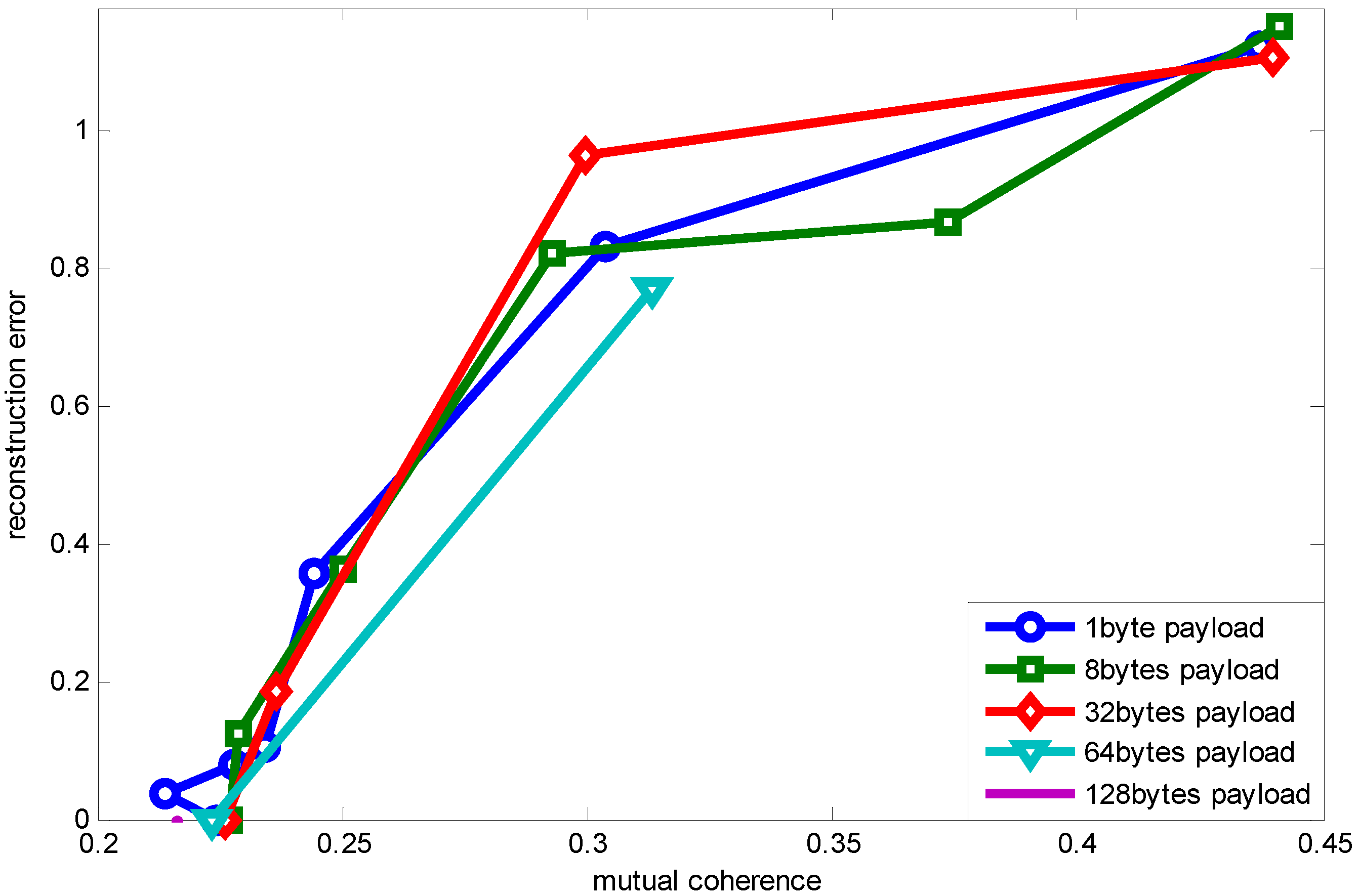
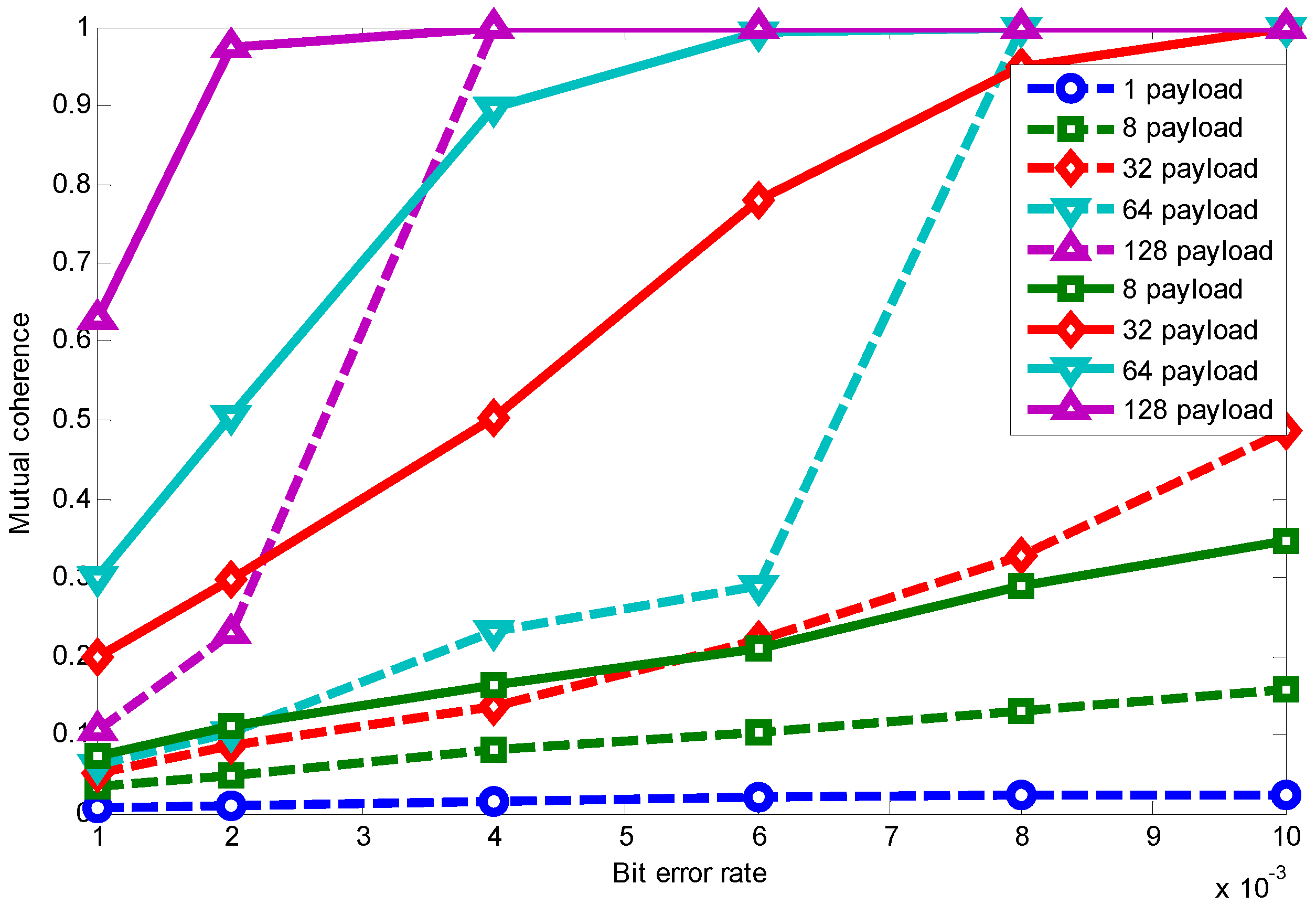
5.3.3. Interleaving Length
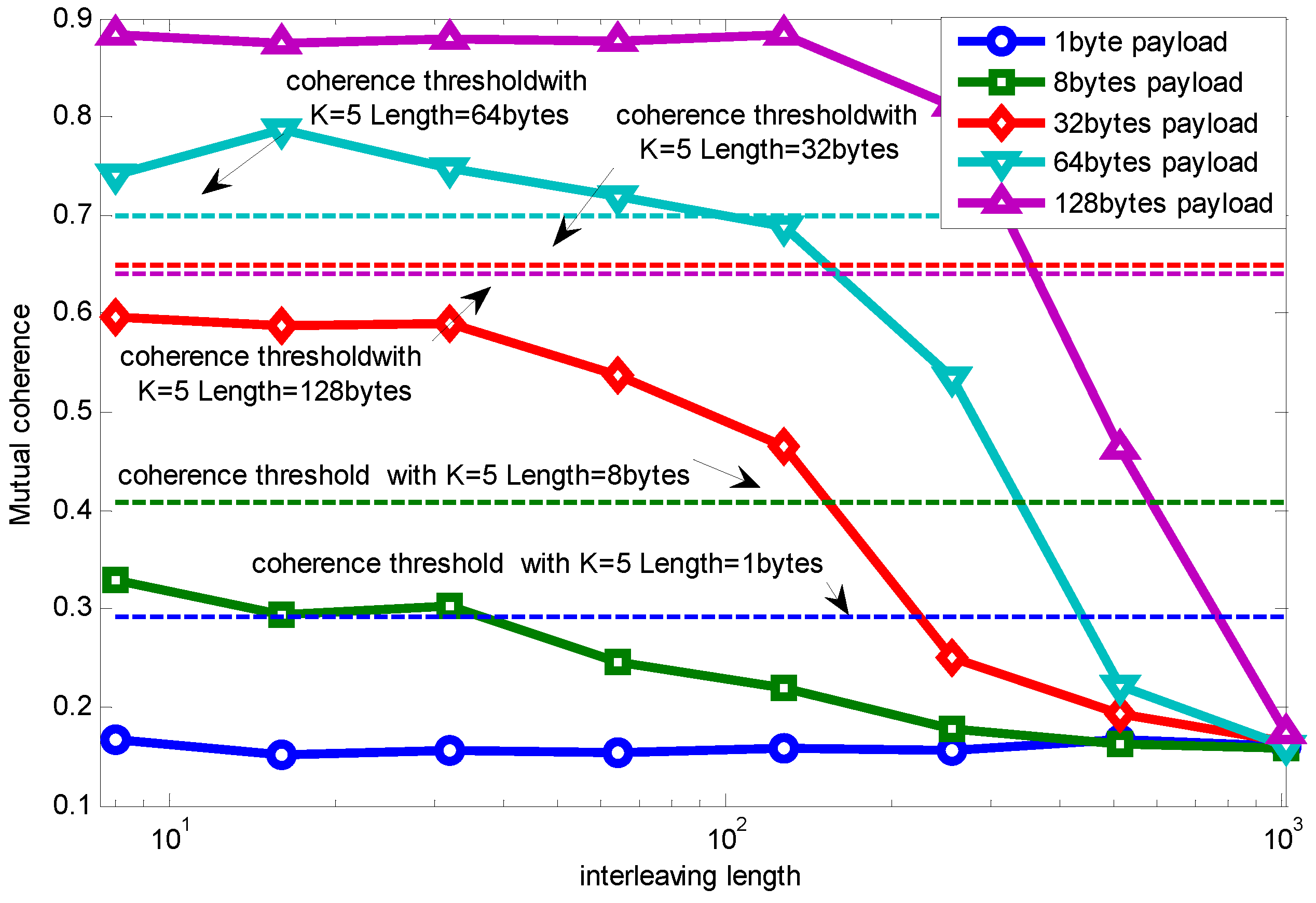
6. Performance Evaluation
6.1. Performance Comparison on Signal Reconstruction
| Tx Power | 0 dB |
| Channel number | 11 |
| Simulation time | 4 s |
| Max frame retries | 0 or 2 |
| Overhead length | 10 bytes |
| Minimum packet length | 11 bytes |
| Maximum packet length | 127 bytes |
| Minimum distance between sender and receiver | 98 m |
| Maximum distance between sender and receiver | 128 m |
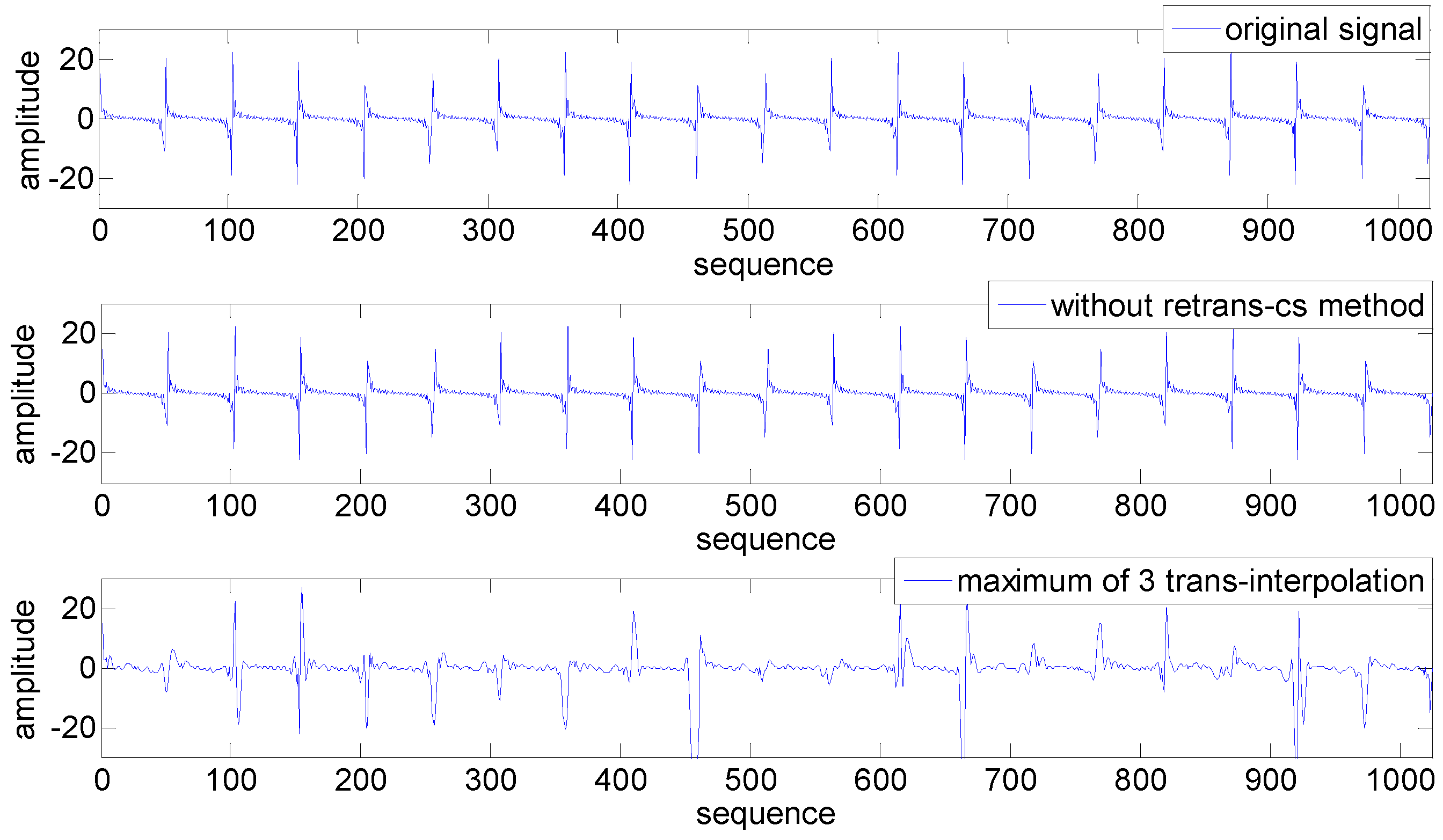
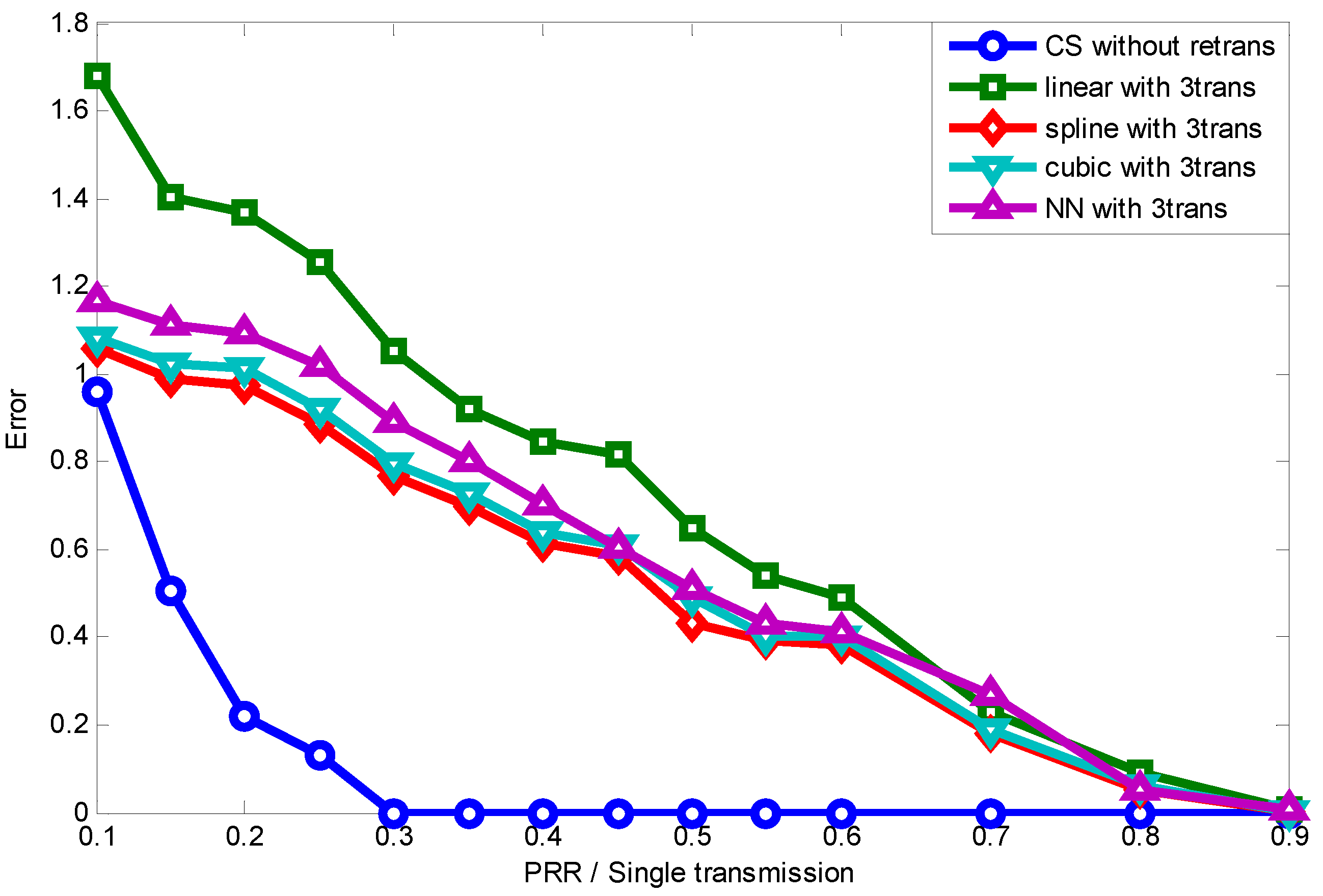

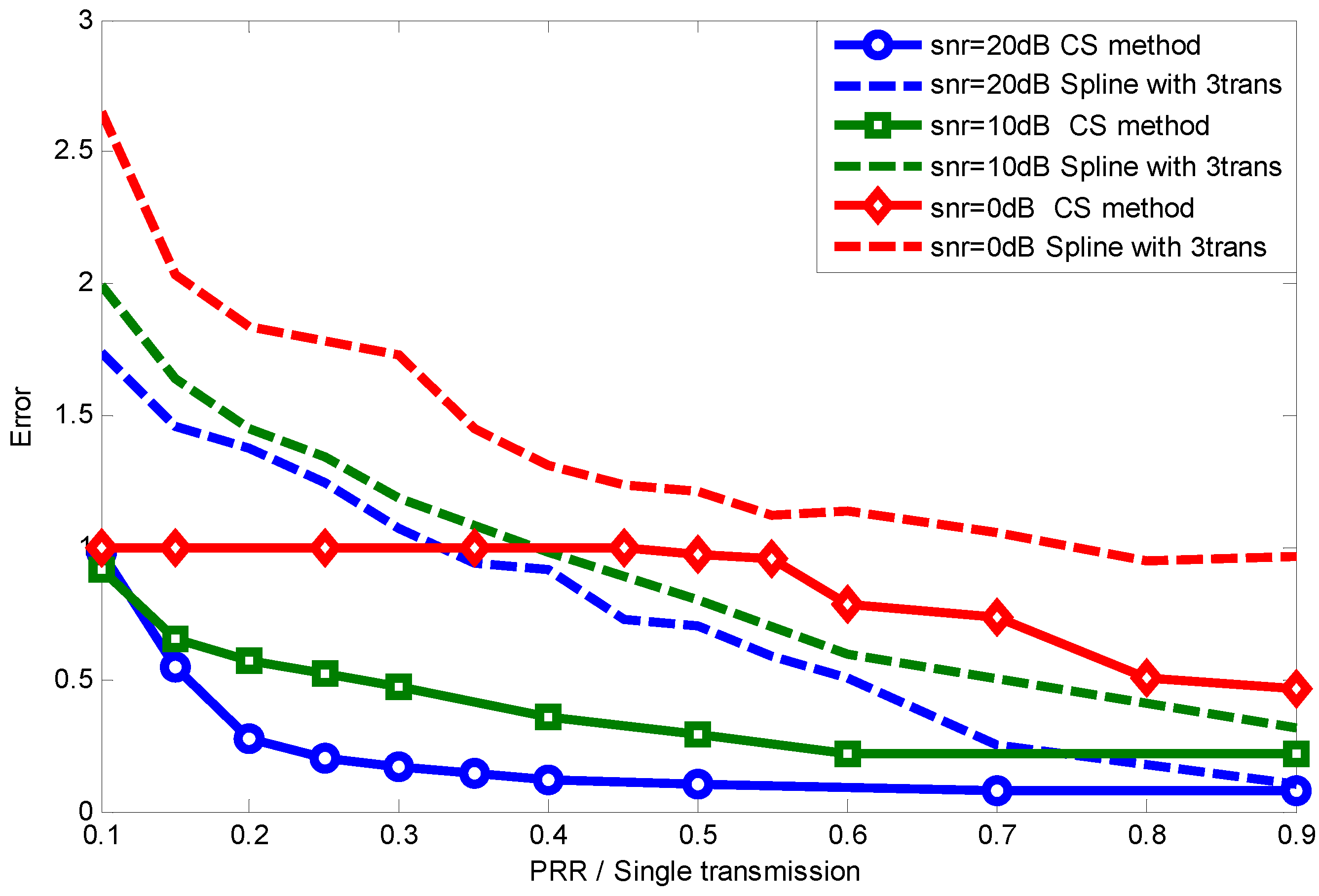
6.2. Packet Length Effect on Sparse Signal Transmission
6.2.1. Performance under Varying BER
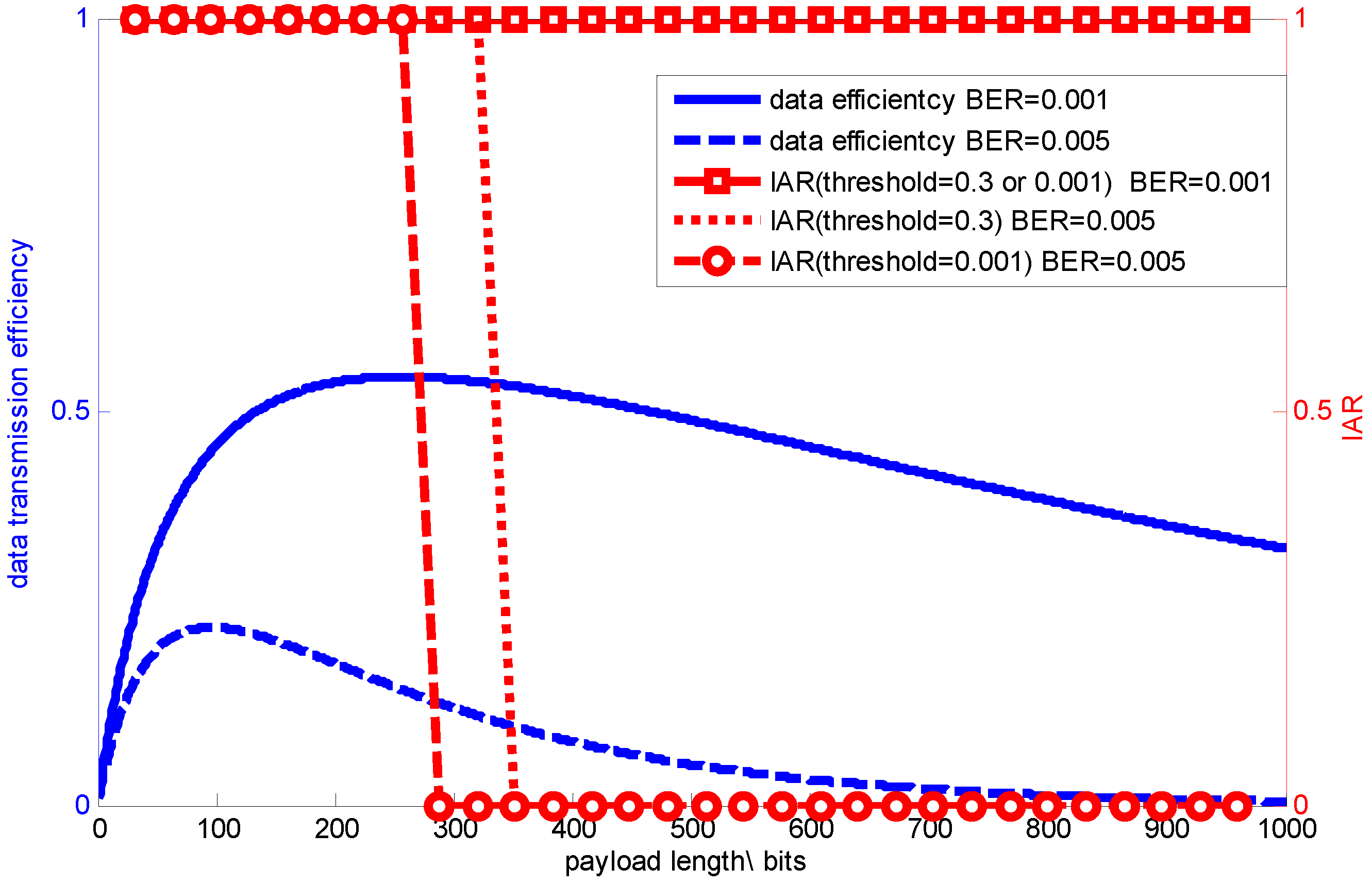
6.2.2. Performance under Varying Signal Sparsity (Various Applications)
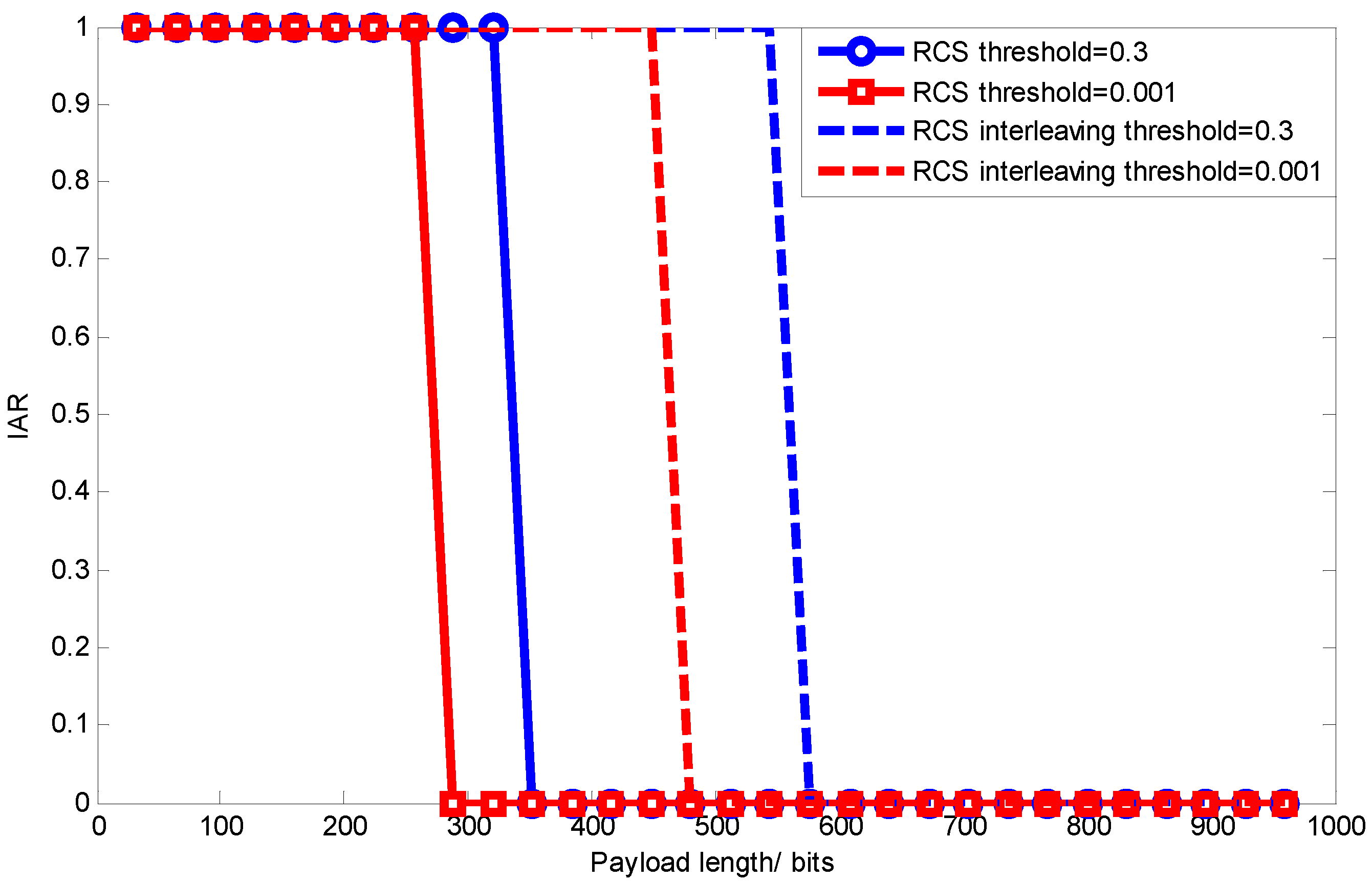

7. Experimental Verification
7.1. Sparse Signal Transmission Performance
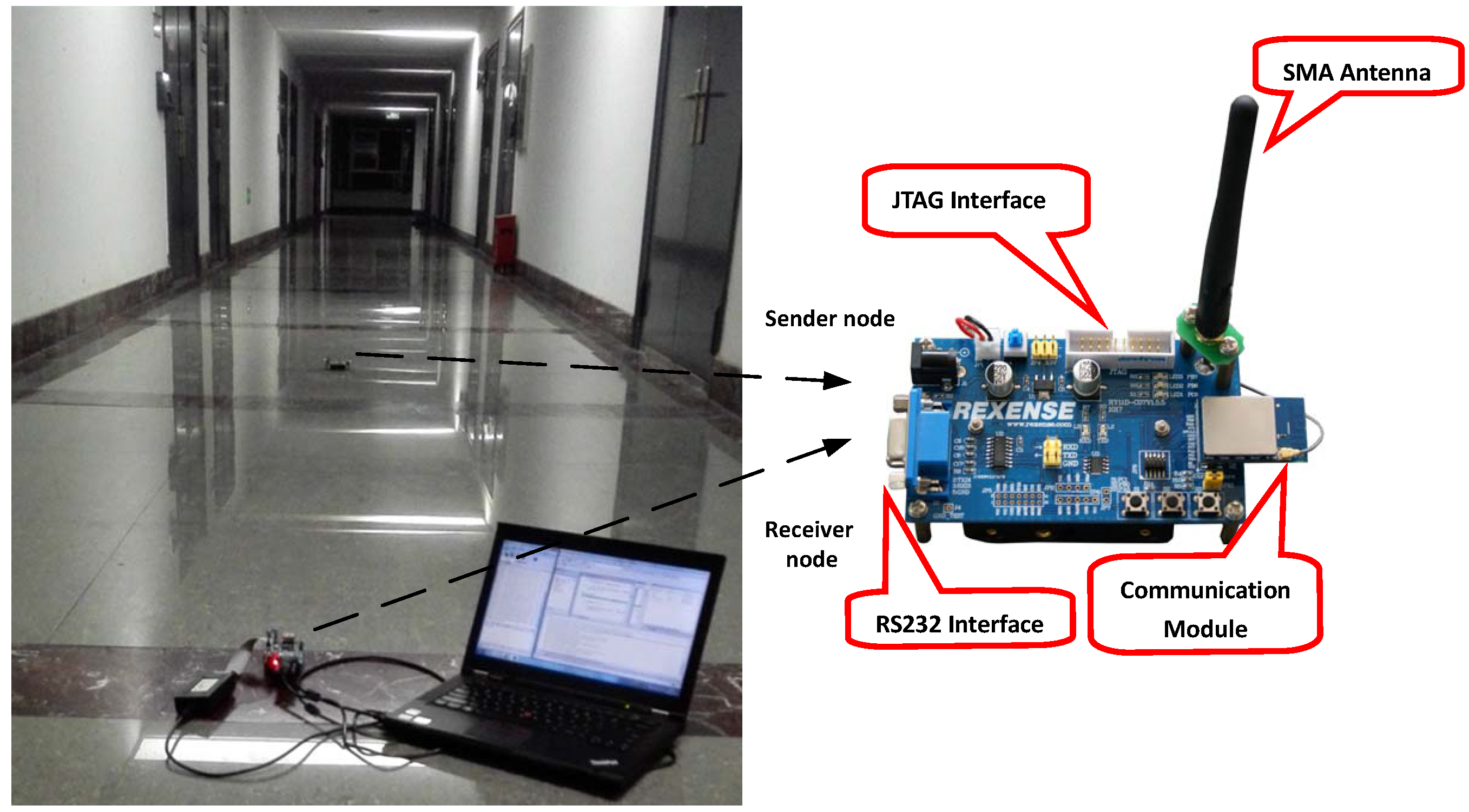
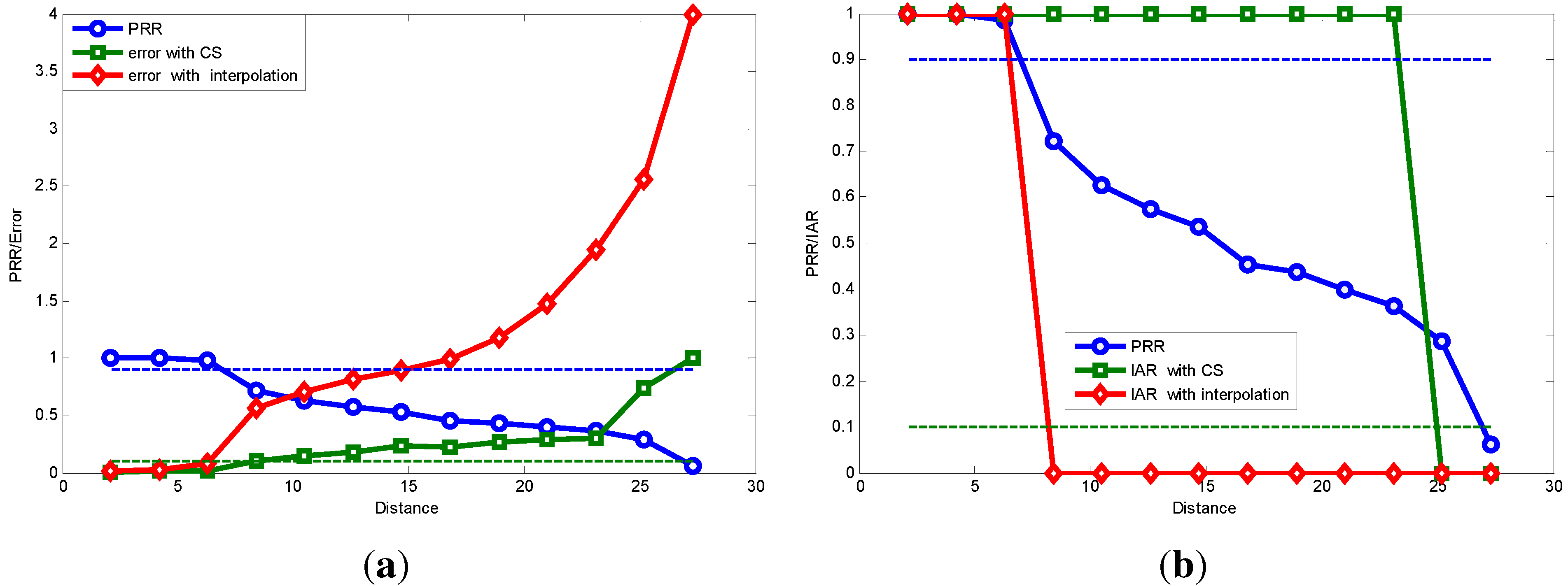
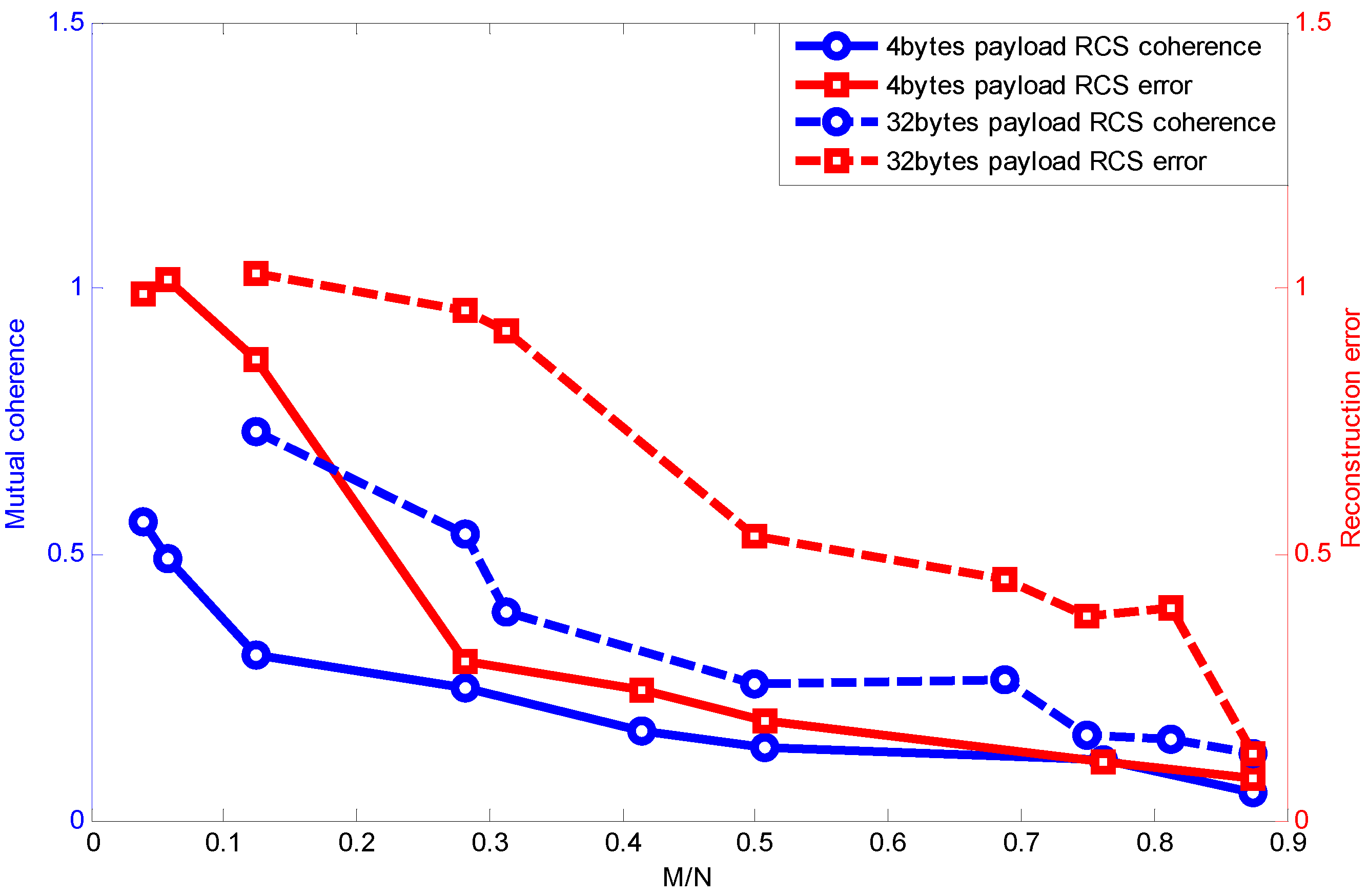
7.2. Packet Length Effect Verification
7.3. Interleaving Improvement Verification
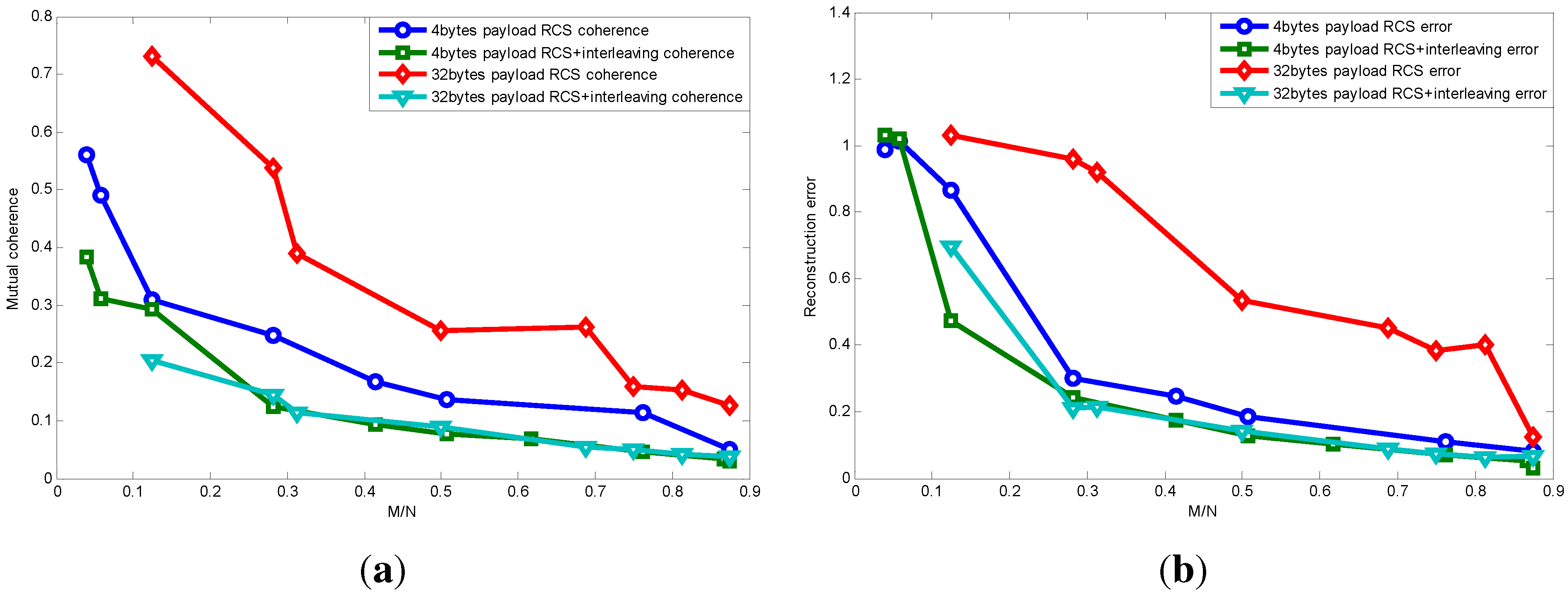
8. Conclusions
Acknowledgments
Author Contributions
Conflicts of Interest
References
- Huang, P.; Xiao, L.; Soltani, S. The evolution of MAC protocols in wireless sensor networks: A survey. IEEE Commun. Surv. Tutor. 2013, 15, 101–120. [Google Scholar] [CrossRef]
- Baccour, N.; Koubaa, A.; Mottola, L. Radio link quality estimation in wireless sensor networks: A survey. ACM Trans. Sens. Netw. 2012, 8. [Google Scholar] [CrossRef]
- Ndzi, D.L.; Arif, M.A.M.; Shakaff, A.Y.M. Signal propagation analysis for low data rate wireless sensor network applications in sport grounds and on roads. Progr. Electromagn. Res. 2012, 125, 1–19. [Google Scholar] [CrossRef]
- Ahmed, N.; Kanhere, S.S.; Jha, S. Utilizing Link Characterization for Improving the Performance of Aerial Wireless Sensor Networks. IEEE J. Sel. Areas Commun. 2013, 31, 1639–1649. [Google Scholar] [CrossRef]
- Srinivasan, K.; Kazandjieva, M.A.; Agarwal, S. The β-factor: Measuring wireless link burstiness. In Proceedings of the 6th ACM Conference on Embedded Network Sensor Systems (SenSys), Raleigh, NC, USA, 5–7 November 2008; pp. 29–42.
- Munir, S.; Lin, S.; Hoque, E. Addressing burstiness for reliable communication and latency bound generation in wireless sensor networks. In Proceedings of the 9th ACM/IEEE International Conference on Information Processing in Sensor Networks (IPSN), Stockholm, Sweden, 12–16 April 2010; pp. 303–314.
- Charbiwala, Z.; Chakraborty, S.; Zahedi, S. Compressive oversampling for robust data transmission in sensor networks. In Proceedings of the 29th IEEE International Conference on Computer Communications (INFOCOM), San Diego, CA, USA, 15–19 March 2010; pp. 1–9.
- Razzaque, M.A.; Dobson, S. Energy-Efficient Sensing in Wireless Sensor Networks Using Compressed Sensing. Sensors 2014, 14, 2822–2859. [Google Scholar] [CrossRef] [PubMed]
- Candes, E.J.; Tao, T. Decoding by linear programming. IEEE Trans. Inf. Theory 2005, 51, 4203–4215. [Google Scholar] [CrossRef]
- Candes, E.J.; Romberg, J.; Tao, T. Robust uncertainty principles: Exact signal reconstruction from highly incomplete frequency information. IEEE Trans. Inf. Theory 2006, 52, 489–509. [Google Scholar] [CrossRef]
- Bajwa, W.; Haupt, J.; Sayeed, A.; Nowak, R. Compressive Wireless Sensing. In Proceedings of the 5th International Conference on Information Processing in Sensor Networks (IPSN), Nashville, TN, USA, 19–21 April 2006; pp. 134–142.
- Wu, L.T.; Yu, K.; Hu, Y.H.; Wang, Z. CS-based Framework for Sparse Signal Transmission over Lossy Link. In Proceedings of the 11th IEEE International Conference on Mobile Ad-Hoc and Sensor Systems (MASS), Philadelphia, PA, USA, 28–30 Octobor 2014; pp. 680–685.
- Singh, J.; Pesch, D. Fuzzy Inference Based Delay and Channel Aware Communication in Low-Power Sensor Networks. In Proceedings of the 8th IEEE International Conference on Distributed Computing in Sensor Systems (DCOSS), Hangzhou, Zhejiang, China, 16–18 May 2012; pp. 384–391.
- Brown, J.; McCarthy, B.; Roedig, U. Burstprobe: Debugging time-critical data delivery in wireless sensor networks. Wirel. Sens. Netw. 2011, 6567, 195–210. [Google Scholar]
- Kong, L.; Xia, M.; Liu, X.Y.; Wu, M.Y.; Liu, X. Data loss and reconstruction in sensor networks. In Proceedings of the 32th IEEE International Conference on Computer Communications (INFOCOM), Turin, Italy, 14–19 April 2013; pp. 1654–1662.
- Rodger, J.A. Toward reducing failure risk in an integrated vehicle health maintenance system: A fuzzy multi-sensor data fusion Kalman filter approach for IVHMS. Expert Syst. Appl. 2012, 39, 9821–9836. [Google Scholar] [CrossRef]
- Luo, C.; Wu, F.; Sun, J. Compressive data gathering for large-scale wireless sensor networks. In Proceedings of the 15th annual international conference on Mobile computing and networking(MobiCom), Beijing, China, 20–25 September 2009; pp. 145–156.
- Luo, C.; Wu, F.; Sun, J. Efficient measurement generation and pervasive sparsity for compressive data gathering. IEEE Trans. Wirel. Commun. 2010, 9, 3728–3738. [Google Scholar] [CrossRef]
- Wang, J.; Tang, S.; Yin, B.; Li, X.Y. Data gathering in wireless sensor networks through intelligent compressive sensing. In Proceedings of the 31th IEEE International Conference on Computer Communications (INFOCOM), Orlando, FL, USA, 25–30 March 2012; pp. 603–611.
- Lin, T.H.; Kung, H.T. Compressive Sensing Medium Access Control for Wireless LANs. In Proceedings of the IEEE Global Telecommunications Conference (GLOBECOM), Anaheim, CA, USA, 3–7 December 2012; pp. 5470–5475.
- Lin, T.H.; Kung, H.T. Concurrent channel access and estimation for scalable multiuser MIMO networking. In Proceedings of the 32nd IEEE International Conference on Computer Communications (INFOCOM), Turin, Italy, 14–19 April 2013; pp. 140–144.
- Fazel, F; Fazel, M.; Stojanovic, M. Random access compressed sensing for energy-efficient underwater sensor networks. IEEE J. Sel. Areas Commun. 2011, 29, 1660–1670. [Google Scholar] [CrossRef]
- Li, S.C.; Li, D.X.; Wang, X.H. Compressed sensing signal and data acquisition in wireless sensor networks and internet of things. IEEE Trans. Ind. Inf. 2013, 9, 2177–2186. [Google Scholar] [CrossRef]
- Candes, E.J.; Romberg, J.K.; Tao, T. Stable signal recovery from incomplete and inaccurate measurements. Commun. Pure Appl. Math. 2006, 59, 1207–1223. [Google Scholar] [CrossRef]
- Duarte, M.; Eldar, Y. Structured compressed sensing: From theory to applications. IEEE Trans. Signal Process. 2011, 59, 4053–4085. [Google Scholar] [CrossRef]
- Raghavan, V.; Hariharan, G.; Sayeed, A.M. Capacity of sparse multipath channels in the ultra-wideband regime. IEEE J. Sel. Top. Signal Process. 2007, 1, 357–371. [Google Scholar] [CrossRef]
- Hayashi, K.; Nagahara, M.; Tanaka, T. A user’s guide to compressed sensing for communications systems. IEICE Trans. Commun. 2013, 96, 685–712. [Google Scholar] [CrossRef]
- Zamalloa, M.Z.; Krishnamachari, B. An Analysis of Unreliability and Asymmetry in Low-Power Wireless Links. ACM Trans. Sens. Netw. 2007, 3. [Google Scholar] [CrossRef]
- STM32W108 datasheet. Feburary 2011. Available online: http://www.datasheetarchive.com/dl/Datasheets-SX28/DSASW0061324.pdf (accessed on 27 July 2015).
- BeACON Dataset. 2012. Available online: http://beacon.berkeley.edu/Sites/Skyline.aspx (accessed on 10 May 2015).
- Intel Lab Data. 2004. Available online: http://db.csail.mit.edu/labdata/labdata.html (accessed on 10 May 2015).
- Volcano Monitoring (Reventador) Dataset. 2005. Available online: http://fiji.eecs.harvard.edu/Volcano (accessed on 10 May 2015).
- Yu, K.; Yin, M.; Hu, Y.H.; Wang, Z. Coscor framework for doa estimation on wireless array sensor network. In Proceedings of the IEEE China Summit & International Conference on Signal and Information Processing (ChinaSIP), Beijing, China, 6–10 July 2013; pp. 215–219.
- Yu, K.; Yin, M.; Bao, M.; Hu, Y.H.; Wang, Z. A direct wideband direction of arrival estimation under compressive sensing. In Proceedings of the 11th IEEE International Conference on Mobile Ad-Hoc and Sensor Systems (MASS), Hangzhou, China, 14–16 October 2013; pp. 603–608.
- Sai, J.; Sun, Y.J.; Shen, J. A method of data recovery based on compressive sensing in wireless structural health monitoring. Math. Probl. Eng. 2014. [Google Scholar] [CrossRef]
- Elad, M. Optimized Projections for Compressed Sensing. IEEE Trans. Signal Process. 2007, 55, 5695–5702. [Google Scholar] [CrossRef]
- Tanenbaum, A.S.; Wetherall, D.J. Computer Networks, 5rd ed.; Pearson: Amsterdam, The Netherlands, 2011. [Google Scholar]
- Yu, K.; Yin, M.; Luo, J.A.; Bao, M.; Hu, Y.H.; Wang, Z. WSAN DoA Estimation from Compressed Array Data via Joint Sparse Representation. IEEE Trans. Signal Process. submitted.
- Li, G.; Zhu, Z.; Yang, D. On Projection Matrix Optimization for Compressive Sensing Systems. IEEE Trans. Signal Process. 2013, 61, 2887–2898. [Google Scholar] [CrossRef]
- Donoho, D.L.; Elad, M. Optimally sparse representation in general (nonorthogonal) dictionaries via l1 minimization. Proc. Natl. Acad. Sci. USA 2003, 100, 2197–2202. [Google Scholar] [CrossRef] [PubMed]
- Chen, W.; Rodrigues, M.R.D.; Wassell, I.J. Projection design for statistical compressive sensing: A tight frame based approach. IEEE Trans. Signal Process. 2013, 61, 2016–2029. [Google Scholar] [CrossRef]
- Fazel, F.; Fazel, M.; Stojanovic, M. Random Access Compressed Sensing over Fading and Noisy Communication Channels. IEEE Trans. Wirel. Commun. 2013, 12, 2114–2125. [Google Scholar] [CrossRef]
- Rappaport, T.S. Wireless Communications Principles and Practice, 2nd ed.; Prentice Hall PTR: New Jersey, NJ, USA, 1996. [Google Scholar]
- Zuniga, M.; Krishnamachari, B. Analyzing the transitional region in low power wireless links. In Proceedings of the 1st Annual IEEE Communications Society Conference on Sensor and Ad Hoc Communications and Networks (SECON), Santa Clara, CA, USA, 4–7 October 2004; pp. 517–526.
© 2015 by the authors; licensee MDPI, Basel, Switzerland. This article is an open access article distributed under the terms and conditions of the Creative Commons Attribution license (http://creativecommons.org/licenses/by/4.0/).
Share and Cite
Wu, L.; Yu, K.; Cao, D.; Hu, Y.; Wang, Z. Efficient Sparse Signal Transmission over a Lossy Link Using Compressive Sensing. Sensors 2015, 15, 19880-19911. https://doi.org/10.3390/s150819880
Wu L, Yu K, Cao D, Hu Y, Wang Z. Efficient Sparse Signal Transmission over a Lossy Link Using Compressive Sensing. Sensors. 2015; 15(8):19880-19911. https://doi.org/10.3390/s150819880
Chicago/Turabian StyleWu, Liantao, Kai Yu, Dongyu Cao, Yuhen Hu, and Zhi Wang. 2015. "Efficient Sparse Signal Transmission over a Lossy Link Using Compressive Sensing" Sensors 15, no. 8: 19880-19911. https://doi.org/10.3390/s150819880
APA StyleWu, L., Yu, K., Cao, D., Hu, Y., & Wang, Z. (2015). Efficient Sparse Signal Transmission over a Lossy Link Using Compressive Sensing. Sensors, 15(8), 19880-19911. https://doi.org/10.3390/s150819880






